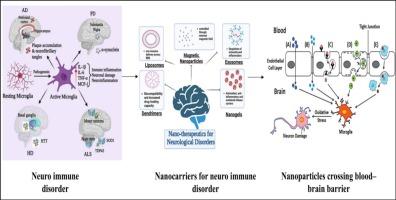神经免疫疾病的纳米治疗进展:现状和未来展望。
IF 2.8
3区 医学
Q2 NEUROSCIENCES
引用次数: 0
摘要
神经免疫疾病涉及神经系统和免疫系统之间复杂的相互作用,导致各种严重的神经系统疾病,如阿尔茨海默病、帕金森病和多发性硬化症。这些疾病的特征是神经组织内免疫介导的损伤或炎症,导致认知缺陷、运动问题、感觉障碍和其他神经系统问题。它们可以影响所有年龄段的人,但发病率随着年龄的增长而显著增加,使其成为一个日益严重的公共卫生问题。随着全球人口老龄化,神经免疫疾病的患病率预计将急剧上升。预测表明,到2050年,全世界约有1.5亿人可能仅患有与痴呆症相关的疾病,经济负担将达到约10万亿美元。目前的治疗主要集中在症状管理,旨在减缓疾病进展和改善生活质量。新兴的治疗策略显示出希望,特别是纳米医学,它使用纳米级材料将药物精确地输送到受影响的组织。这种有针对性的方法减少了副作用,提高了治疗效果。此外,天然产物和植物基化合物因其神经保护作用而受到关注,因为它们可以调节涉及神经元存活、修复和免疫调节的途径。未来的研究旨在通过先进的实验模型和技术加深对这些疾病的分子和遗传机制的理解。这些见解将促进针对神经炎症和免疫失调的创新疗法的发展,目标是预防疾病进展甚至实现治愈。神经免疫学的持续进步为改善治疗结果、减轻疾病负担和全球神经保健的变革性进步提供了希望。本文章由计算机程序翻译,如有差异,请以英文原文为准。

Advancing nanotheranostics for neuro-immunological disorders: current status and future prospects
Neuroimmunological disorders involve complex interactions between the nervous and immune systems, leading to various severe neurological conditions such as Alzheimer’s disease, Parkinson’s disease, and multiple sclerosis. These disorders are characterized by immune-mediated damage or inflammation within nervous tissue, resulting in cognitive deficits, movement issues, sensory impairments, and other neurological problems. They can affect people of all ages, but incidence increases significantly with advancing age, making them a growing public health concern. As the global population ages, the prevalence of neuroimmunological diseases is expected to rise sharply. Projections indicate that by 2050, approximately 150 million individuals worldwide may suffer from dementia-related disorders alone, with an economic burden reaching around $10 trillion. Current therapies mainly focus on symptom management, aiming to slow disease progression and improve quality of life. Emerging therapeutic strategies show promise, particularly nanomedicine, which employs nanoscale materials to deliver drugs precisely to affected tissues. This targeted approach reduces side effects and increases treatment effectiveness. Additionally, natural products and plant-based compounds are gaining attention for their neuroprotective effects, as they can modulate pathways involved in neuronal survival, repair, and immune regulation. Future research aims to deepen understanding of the molecular and genetic mechanisms underlying these disorders through advanced experimental models and technologies. These insights will facilitate the development of innovative therapies targeting neuroinflammation and immune dysregulation, with the goal of preventing disease progression or even achieving cures. Continued progress in neuroimmunology offers hope for improved treatment outcomes, reduced disease burden, and transformative advances in neurological healthcare worldwide.
求助全文
通过发布文献求助,成功后即可免费获取论文全文。
去求助
来源期刊

Neuroscience
医学-神经科学
CiteScore
6.20
自引率
0.00%
发文量
394
审稿时长
52 days
期刊介绍:
Neuroscience publishes papers describing the results of original research on any aspect of the scientific study of the nervous system. Any paper, however short, will be considered for publication provided that it reports significant, new and carefully confirmed findings with full experimental details.
 求助内容:
求助内容: 应助结果提醒方式:
应助结果提醒方式:


